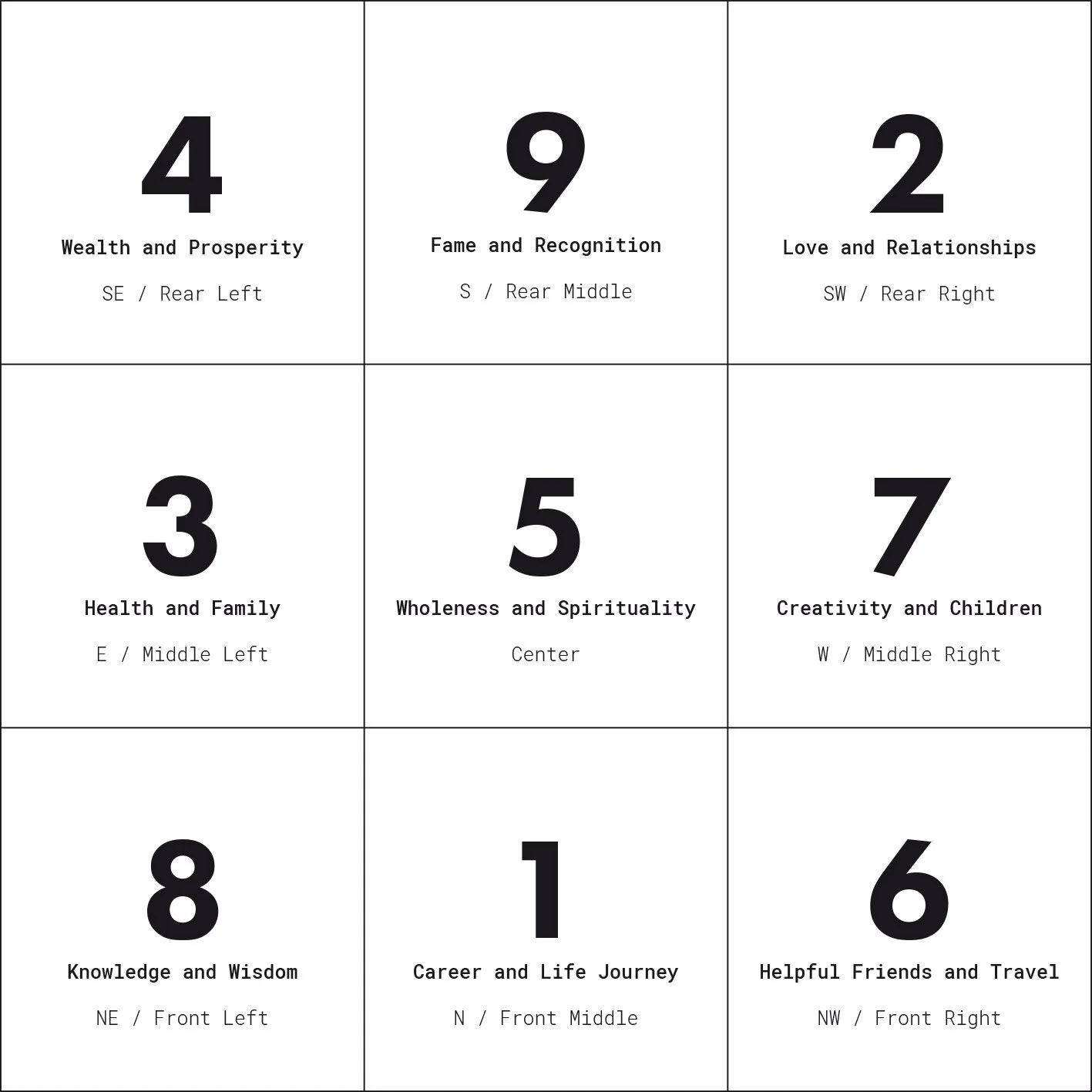A Turtle Explains The World
Did you ever wonder how Feng Shui was ‘invented’ and how you know where the wealth corner is located in your home? Well: This is the story of the Lo Shu turtle and how you can boost the energy in your life areas, using Feng Shui and the magic Bagua square.
–
Lo Shu Turtle
>
Once Upon A Time ...
According to ancient, Chinese legend, there was a big flood in the area of the Lo River, about 3000 BC. To calm the river God, the population offered sacrifices when a big turtle emerged from the river, with a curious pattern on its shell: A magic square with a 3 × 3 grid, in which circular dots of numbers were arranged, such that the sum of the numbers in each row, column and diagonal was the same: 15.
You have to know, that since ancient times turtles are considered as mysterious and symbolic animals. They get very, very old and therefore embody immortality or at least longevity. Many cultures shared the idea that the earth lies on a large turtle, or that the inhabited world is a cosmic turtle’s shell, rising from the water. Hand in hand with the attribution of age comes wisdom; if a creature has lived so long, seen so much and heard so much, it must have drawn a great deal of knowledge from all those experiences, after all. In addition turtles are considered to be stable, calm and thoughtful.
In ancient China, the turtle’s symbolism was alike. One compared its shell with the firmament and the underside with the flat disc of the earth, so the turtle became a symbol for the universe itself, for eternity, wisdom and knowledge. Thus it hardly surprises that the savants of that time immediately recognized the message and the universal harmony of that magical square on the backjside of the Lo Shu turtle.
A New Universe Unfolds
From there it was a short step to understand the duality of Yin and Yang, the natural flow of Qi and to develop the system of the five phases (five elements) and the eight trigrams. All together representing the principles of reality and defining the fundamental knowledge of Taoist cosmology, including Feng Shui, the I Ching and Traditional Chines Medicine, to name just a few systems.
+
Lo Shu Turtle, Giclée Print
The symbol of the Lo Shu turtle can help you to win new knowledge and luck in every area of your life. With its fundamental importance in Feng Shui, this symbol best unfolds its positive power in the center of your home, but also in the North, the natural home of the turtle.
Bagua Poster, Giclée Print
The Bagua is the most important instrument practising Feng Shui, also in the tradition of symbolic Feng Shui. The word Bagua literally means “eight symbols” and refers to the eight trigrams, the basic modules of the I Ching. One trigram is assigned to each of the eight surrounding squares (areas) – the central, ninth field is usually related to the yin and yang symbol. Each small square within that Bagua map represents a life area, and is related to a specific element, energy, theme, color, shape, cardinal direction, season, and many other qualities. To understand how Feng Shui and the flow of energy (Qi) works, it is essential to understand the cycle of the five phases. If your not familiar with this concept, please read my article about the five phases and the five celestial animals first.
/
Bagua Map (Lo Shu Square)
Adapting the Bagua map to your home isn’t complicated. Basically the square is superimposed to the plan of your home. Length and width of the square are flexible, it doesn’t have to be a regular square, any rectangular shape works fine, as long as it covers all your plan and all nine areas are equally sized.
Small expansions, like oriels or vestibules e.g., with less than half of a side width, may look out of the Bagua map. You can regard them as extensions to the life area they touch. Missing parts and cut ins need to be cured, generally speaking. This can be done with mirrors, crystals or light for example, depending on the area and your needs.
Similarly to the home, one can also divide a single room, or even the surface of a desk into nine different life areas.
Depending on Feng Shui school, the Bagua is either aligned to the cardinal directions of the compass or to the position of the front entrance. The latter one is more popular in the Western world and easier to apply as it is always based on the location of the front door. Which ever variation you choose, stick to it and don’t mix.
Attention! On Chinese plans and maps the starting point (North or front door) is on the bottom of the page, not at the top! From this point, all the nine squares line up.
:
Now you’re ready to define the life areas in your home! Please refer to the individual life area posts for information and tips about the individual Bagua zones:
> Career and Life Journey (1)
> Love and Relationships (2)
> Health and Family (3)
> Wealth and Prosperity (4)
> Wholeness and Spirituality (5)
> Helpful Friends and Travel (6)
> Creativity and Children (7)
> Knowledge and Wisdom (8)
> Fame and Recognition (9)
Note! Not every home has an optimal, rectangular ground plan and not every room is located in its appropriate life area. Using suitable Feng Shui charms and symbols can harmonize and strengthen Bagua zones, missing corners or energetically unbalanced areas. This site mentions a few general information, tools and practices but can’t replace a energetic Feng Shui consultant, of course. For more complex and individual solutions it’s always worth to invest in a pro!




